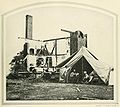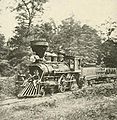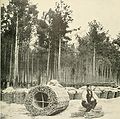-
12-pounder breech-loading Whitworth gun
-
50th New York Engineers in Winter camp at Rappahannock Station, Virginia.
-
Union 300-pounder Parrott rifle with a ruptured barrel in Battery Strong on Morris Island.
-
Confederate 600-pounder rifled gun inside Fort Moultrie.
-
Confederate Lieutenant Adam J. Slemmer on a mortar aimed at Union-controlled Fort Pickens in 1861.
-
Photo taken of damage from a massive explosion near Ulysses S. Grant's headquarters at City Point on August 9, 1864. A barge blew up killing about 70 men and wounding 130 while destroying warehouses and wharf.
-
Photographed from angle where Union artillery fired upon Fort Pulaski.
-
Inside look at the damage of the breached casemate at Fort Pulaski.
-
Confederate horses lay dead and artillery caissons destroyed on Antietam battlefield
-
Battery Brooke at Drewry's Bluff
-
Bomb shelter at Battery Brooke, Drewry's Bluff
-
Union Parrott rifles in Battery Hays are aimed at Fort Sumter.
-
Union Battery Reno trains its guns upon Confederate Battery Wagner
-
8.5" Armstrong projectiles are stored at Battery Magruder at Yorktown
-
Union Battery Rodgers near Alexandria, Virginia, serves to defend Washington. A 15" Rodman gun bears on the Potomac River
-
100 pounder Parrott rifles at Union Battery Rosecrans are trained upon Battery Wagner
-
Battery Wagner on Morris Island
-
This fourth bridge rebuilt over the Potomac Creek was glibly referred to as the "Beanpole and Cornstalk" Bridge by Abraham Lincoln
-
Union blockhouse near Aqueduct Bridge, Arlington Heights, Virginia
-
Broadway Landing over the Appomattox River where Baldy Smith marched Union forces across this pontoon bridge in the first attack against Petersburg in 1864
-
A Confederate Columbiad bears toward Chaffin's Bluff on the James River from within Fort Darling
-
-
Beast Butler's dredge-boat lay sunken in the James River, destroyed by a Confederate shell on Thanksgiving Day, 1864
-
A single Union canvas pontoon boat is assembled to be used for pontoon bridges
-
A 15" Columbiad is shown with its 428 lb. projectiles inside Castle Pinckney
-
Union Major General Charles Griffin with Fifth Corps staff in April 1865
-
Union General Quincy Adams Gillmore studies Charleston Harbor on a map of the South Carolina coast while posing for this photo in 1863
-
Various munitions in the Charleston Arsenal yard
-
Partial map of Union and Confederate fortifications in Charleston Harbor during Union siege of Fort Sumter
-
Confederate-built Chevaux de frise line Marietta Street as part of the defense network of Atlanta in 1864.
-
Confederate-built Chevaux de frise line Marietta Street as part of the defense network of Atlanta in 1864
-
Confederate-built Chevaux de frise line Marietta Street as part of the defense network of Atlanta in 1864
-
A vignette of Confederate-built Chevaux de frise
-
Confederate-built Chevaux de frise line Marietta Street as part of the defense network of Atlanta in 1864
-
Confederate fortification line protecting Petersburg
-
The "Coonskin" Tower served as a lookout and sniping platform during the Siege of Vicksburg for sharpshooters from the 23rd Indiana Infantry
-
Cowan's Battery advances across the Warwick River on May 4, 1862 before they engage in the Battle of Williamsburg. The Confederate fieldworks that lay before them is the site where the 1st Vermont Brigade was repelled on April 16 during the Battle of Yorktown.
-
The stacks of the CSS Virginia II (right) and the wheels of the CSS Jamestown (center) are visible in the James River. They were sunk on the evening of April 2, 1865 with Abraham Lincoln listening to the action as a guest on board the USS Malvern just downstream.
-
The wheels of the CSS Jamestown are visible in the James River. It sank due to mortar fire on the evening of April 2, 1865 with Abraham Lincoln listening to the action as a guest on board the USS Malvern just downstream.
-
After the Confederates abandoned Morris Island on Sept. 7, 1863, the Union occupied Battery Gregg (also known as the "Cummings Point Battery") pictured here and referred to it as "Battery Chatfield"
-
-
This map of Confederate defenses surrounding Richmond was recovered by Union forces from the body of Brigadier General John R. Chambliss on August 16, 1864
-
The charred remnants of the Confederate arsenal at Richmond
-
Butler ordered the digging of the Dutch Gap Canal in late 1864 in an effort to advance Union troops toward Richmond
-
The Dutch Gap Canal is completed in April 1865
-
-
-
Confederate Colonel Frank Huger
-
Union engineers have just completed the pontoon bridge at Franklin's Crossing on April 29, 1863 just prior to the Battle of Chancellorsville
-
Gabions are heightened by sandbags inside Fort Sedgwick, part of the Union entrenchments in the Siege of Petersburg
-
-
The ruins of the Henry House after the First Battle of Bull Run on July 21, 1861
-
The locomotive, "General Haupt" is being used for work detail while its namesake, Union General Herman Haupt, stands on the hill to the right inspecting railway work near Bull Run in 1863.
-
Inside Confederate Battery Gregg on Morris Island after Union troops have occupied it in the Siege of Fort Sumter, (September 7, 1863)
-
Two Parrott rifles inside Union Battery Stevens on Morris Island began firing upon Confederate fortifications on August 19, 1863 during the Siege of Fort Sumter. Battery Stevens was constructed between July 27 and August 17 with the work being done at night to avoid exposure to Confederate fire.
-
Inside Fort Pulaski in April 1862 after its surrender. Confederates had leaned timbers along the interior of the walls and then piled earth upon them to form a continuous makeshift bombproof.
-
Inside Fort Sedgwick, part of the Union entrenchments in the Siege of Petersburg
-
Inside Fort Sumter in 1865
-
Inside Confederate Fort Johnson, where according to P.G.T. Beauregard's report, the first shot of the war originated on his order at 4:30 am, April 12, 1861. It was an exploding overhead burst fired over Fort Sumter which served as a signal to the remaining Confederate fortifications and batteries to open fire and commence with the Bombardment of Fort Sumter.
-
Two 100 pounder Parrott rifles inside Fort Putnam on Morris Island
-
Stacked ordinance inside Fort Putnam on Morris Island
-
Inside the ramparts of Fort Fisher after its capture
-
Union Brigadier General James Madison Robertson (2nd from left) and staff
-
Federal gunboats have moved up the James River above Dutch Gap Canal near Fort Brady after the Confederates abandoned the shore batteries and evacuated Richmond following the Siege of Petersburg (early April 1865)
-
Confederate Major General Jeremy Francis Gilmer
-
Confederate First Lieutenant John Donnell Smith was photographed in Richmond following the Battle of Chancellorsville in May 1863
-
Union Major General John G. Barnard
-
The lighthouse above the ruins of Fort Sumter just after the Second Battle of Fort Sumter
-
The Union locomotive, "Fred Leach", is photographed on the Orange and Alexandria Railroad after it escaped from Confederates on August 1, 1863 near Union Mills. Holes in the smokestack from Confederate shot are visible.
-
-
Union engineers have built a movable-draw pontoon bridge over the James River to allow vessels to pass through
-
This 60-man garrisoned blockhouse was built near Hunting Creek and Telegraph Road for defending the Orange and Alexandria Railroad
-
-
Union Fort Sedgwick was part of the fieldworks in the Siege of Petersburg
-
Battery A of the 3rd Rhode Island Heavy Artillery occupies the captured and repaired Fort Pulaski whose weapons face Tybee Island.
-
The 3rd Rhode Island Heavy Artillery at drill in the captured and repaired Fort Pulaski
-
Union engineers have constructed a pontoon bridge over the North Anna River in May 1864 for the Battle of North Anna
-
Union engineers have constructed a pontoon bridge over the North Anna River in May 1864 for the Battle of North Anna. This view is from Jericho Mill.
-
The Union army used this pontoon bridge at Powhatan Point (near Harrison's Landing) to cross the James River after the Battle of Cold Harbor on their way to besiege Petersburg in 1864. p. 239.
-
A tripod signal is being used by Union army engineers for surveying and map-making at Pulpit Rock on Lookout Mountain. p. 251.
-
Confederate Quaker gun abandoned at Centreville in 1862. p. 203.
-
Union soldiers stand over their "capture" of Confederate Quaker guns at Manassas in 1861. p. 203.
-
The Union locomotive "General Dix" and its tender are landing at City Point in 1864. The engine weighed 59,000 lbs. and cost $9500. For the fiscal year ending in 1865, the General Dix logged 16,776 miles at an operational cost of $6136.62. p. 289.
-
The remains of the CSS Patrick Henry lies in the James River before Fort Darling, April 1865. p. 313.
-
The damaged Richmond Capitol Building in April 1865 after the city's capture. p. 303.
-
Captured Confederate gun at Fort McAllister after the siege of Savannah in 1864 p. 263.
-
The Confederates mounted this 8 inch smoothbore with a high angle to serve as a makeshift heavy mortar at Tybee Island in the defense of the Savannah River, 1862. p. 259.
-
Ruptured Union gun at Battery Rosecrans, Morris Island, 1863. p. 114.
-
Ruptured Confederate gun at Fort Fisher, 1865 p. 267.
-
The 8 inch, 200 pdr Parrott rifle known as "The Swamp Angel" ruptured on its 36th discharge throwing the barrel onto the earthworks, August 23 1863. The first sixteen charges were incendiary rounds filled with "Greek fire" and fired into the heart of downtown Charleston. p. 116.
-
Union sappers behind the flying sap at the fifth and last parallel at the siege of Battery Wagner, Morris Island on September 6, 1863. This sap-roller will take them to the base of Battery Wagner. p. 117.
-
-
The sea face of Fort Fisher photographed after its capture following the Second Battle of Fort Fisher
-
Union engineers paddle the pontoons into place for constructing the pontoon bridge that will allow Sedgwick to cross the Rappahannock River and trap Lee's army during the Battle of Chancellorsville. Photo taken May 3, 1863. p. 219.
-
Two ten-inch Columbiads at the South Battery in Charleston.
-
-
-
The 8 inch, 200 pdr Parrott rifle known as "The Swamp Angel" aimed at the heart of downtown Charleston on August 21, 1863. p. 116.
-
A ten-inch Columbiad at the South Battery, Charleston
-
On one of the traverses of Fort Fisher after its capture p. 269.
-
Solid shot, grape and mortar shells may be seen in the ruins of Tredegar Iron Works in Richmond p. 191.
-
Tredegar Iron Works in Richmond where the Confederacy made heavy guns p. 307.
-
The Union gunboat Chickamauga in 1864 p. 293.
-
Unexploded 12 inch ordinance may be seen on the land face of Fort Fisher before the Mound Battery p. 269.
-
A Union 6 pdr. Wiard rifle p. 135.
-
Federal Battery #1 was the only battery to fire during the Siege of Yorktown (1862) p. 23.
-
Federal Battery #4 with a sentinel guarding the bomb-proof during the Siege of Yorktown (1862) p. 23.
-
Barrels and gabions are used by the Union soldiers in Fort Sedgwick to strengthen chimneys necessary to heat the bomb-proof burrows underneath. Confederate sharpshooters fired into "Fort Hell" during the Siege of Petersburg in 1864-65. p. 217.
-
The Western Corps of Engineers constructed this draw bridge over the Tennessee River after the battles at Chattanooga p. 253.
-
Union gabions lay waiting for the Siege of Petersburg p. 207.
-
Union soldiers are guarding the Orange and Alexandria Railroad; rifles stacked in the foreground p. 283.
-
The bomb-proof quarters inside Fort Stedman, 1865. The wagon is labeled "Union Photographic Wagon, Engineer Department" and the attendant is resting in its shade. p. 195.
-
The Union Corps of Topographical Engineers were still a separate and distinct branch from the other engineering corp when they were photographed here before Yorktown in May 1862. p. 229.
-
Confederate Brigadier General Walter H. Stevens, Chief Engineer of the Army of Northern Virginia
-
Three batteries of Union Wiard rifles at the Washington Arsenal p. 135.
|





































































































